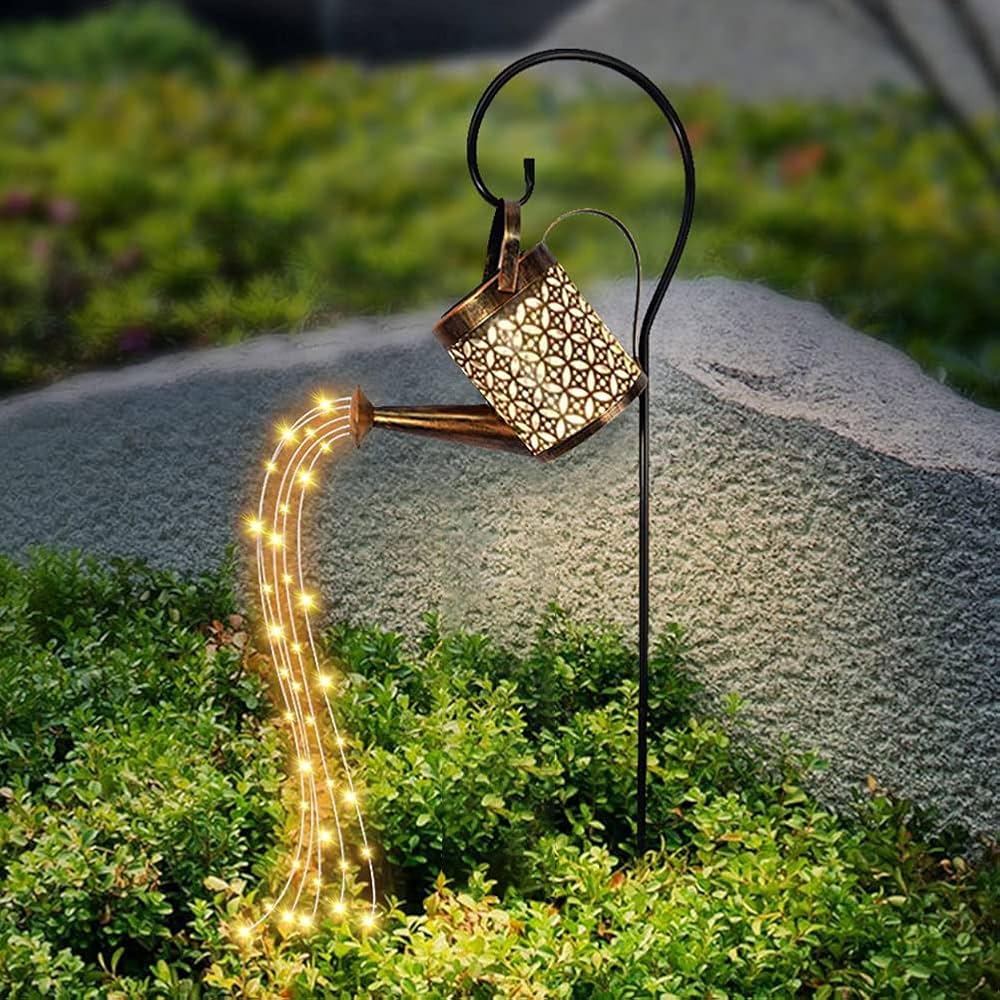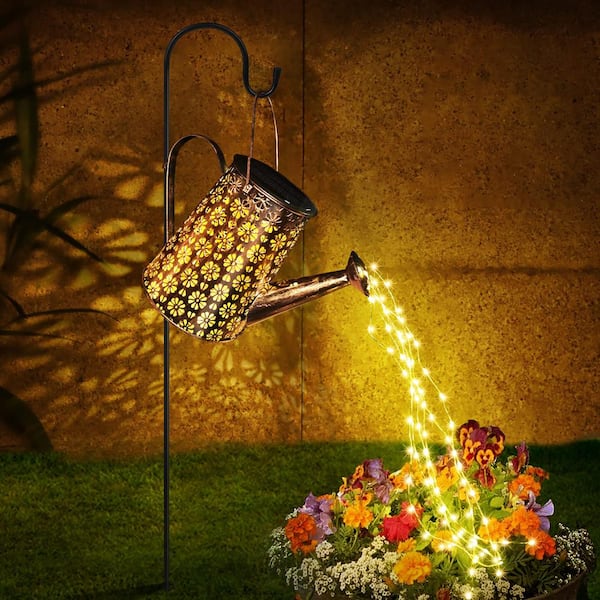The Basics of Solar Watering Cans
A solar watering can is a gardening tool that uses solar energy to help you water plants. It often includes a solar panel. This panel captures sunlight. The energy then powers a motor or a pump. This setup helps move water from the can onto your plants. Such cans come in various shapes and sizes. They all share the common goal of sustainable gardening.
Using a solar watering can is simple. First, you fill the can with water. Next, you place it under the sun to charge. Once charged, you can start watering your plants. This type of watering can is perfect for gardeners looking for eco-friendly options. It not only saves water but also uses renewable energy. Moreover, it’s a great way to cut down on electricity bills.
Solar watering cans are getting popular. They combine technology with traditional gardening practices. Gardeners value sustainability. They often look for ways to reduce their carbon footprint. A solar watering can helps with that. It does so by using less water and no external power. Plus, it can be a part of an off-grid living style.
In summary, a solar watering can is a step toward greener gardening. It uses solar power to operate. Best of all, it makes your gardening eco-friendly. By using this innovative tool, gardeners can enjoy nurturing their gardens while helping the planet.
Advantages of Using a Solar Watering Can
Embracing a solar watering can in your gardening routine offers numerous benefits. Below are the key advantages you can expect when you make the switch from traditional to solar-powered watering solutions:
- Environmentally Friendly: Solar watering cans use the sun’s energy, reducing dependency on electricity or batteries. This means lower carbon emissions and a smaller environmental footprint.
- Energy Cost Savings: They need no external power source, cutting down on utility bills. The sun provides free energy, making it a cost-effective solution in the long run.
- Water Efficiency: Many models are designed to minimize water waste. They deliver water directly to the plant’s base, which limits evaporation and ensures that your plants get just the right amount of water.
- Convenience: Solar watering cans are mostly autonomous. Once charged, they can water plants with minimal human intervention. This feature is perfect for busy gardeners or those with larger gardens.
- Portability: These cans are lightweight and easy to carry. Without the need for an electrical outlet, you can use them anywhere in your garden.
- Innovation and Engagement: Using cutting-edge solar technology in your garden can be rewarding. It invites you to engage with sustainable practices and stay ahead with the latest eco-friendly trends.
Making the move to a solar watering can could transform your gardening experience. Not only will you contribute to the health of the planet, but you’ll also enjoy the practicality and savings it brings. It’s a smart choice for both the environment and your wallet.
How Solar Watering Cans Work
Understanding how solar watering cans work is vital for eco-conscious gardeners. The process hinges on solar energy, a clean and abundant resource. Here’s a simplified breakdown of their operation:
- Solar Panels: The heart of a solar watering can lies in its solar panel. This panel captures sunlight and converts it into electrical energy. The size and efficiency of the panel can impact how quickly the can charges.
- Energy Conversion: Once the solar energy is harnessed, it is converted by a built-in system. This system usually includes a battery. The battery stores energy for future use. This means you can water plants even when it’s cloudy.
- Water Pump: The stored energy powers a small pump. This pump is responsible for moving water from the can to the plants. The flow of water can typically be controlled. This allows for precise watering suited to each plant’s needs.
- Charging Time: The charging time varies depending on sunlight intensity. Most solar watering cans need several hours in full sun to charge completely. But once charged, they can provide consistent watering for a period of time.
- Operation: To operate, simply turn on the can after it’s charged. Water will flow through the nozzle, directed to your plants. No manual pumping or tilting is needed, which saves effort and time.
In summary, solar watering cans harness solar power to provide a convenient and sustainable way to water plants. They combine energy efficiency with user-friendly design, making them an excellent choice for modern gardening.
Types of Solar Watering Cans Available
Several types of solar watering cans are available on the market today. Each offers unique features suited to different gardening needs. Let’s explore some common varieties:
- Standard Solar Watering Cans: These are akin to traditional watering cans but with a solar panel. They’re perfect for small to medium-sized gardens. You can expect a simple design that’s easy to use.
- Solar Watering Cans with Adjustable Flow: Some models offer flow control. You can adjust the water stream. This helps to provide the right amount of water for each plant.
- Large-Capacity Solar Watering Cans: These are designed for larger gardens or for those who don’t want to refill often. They come with bigger storage to hold more water.
- Automated Solar Watering Systems: While not traditional cans, these systems take solar watering to the next level. They can automatically water your plants at set intervals.
- Decorative Solar Watering Cans: These cans combine functionality with style. They look good in your garden while serving the purpose of watering plants efficiently.
When selecting a solar watering can, consider your garden size, watering needs, and personal preferences. Keep in mind that regardless of the type, all solar watering cans aim to provide an eco-friendly way to maintain your garden. Understanding these options will help you make an informed choice for your gardening practice.
Considerations When Choosing a Solar Watering Can
Choosing the right solar watering can is crucial for your gardening success. Here are some factors to consider before making a purchase:
- Garden Size: Assess the size of your garden. A larger area may require a can with more capacity or a solar watering system.
- Plant Types: Different plants need varying amounts of water. Look for a can that offers adjustable flow to cater to diverse watering needs.
- Sunlight Availability: Consider the amount of direct sunlight your garden receives. This will determine the efficiency of the solar panel on the can.
- Battery Life: Check the battery specifications. A good battery will store enough power to water your plants even when the sun isn’t shining.
- Durability: Choose a can made from high-quality materials. It should withstand outdoor conditions and resist wear and tear.
- Ease of Use: Ensure the can is user-friendly. It should be easy to fill, carry, and operate.
- Design: If aesthetics are important to you, select a can that complements your garden’s style.
- Price: Solar watering cans vary in price. Determine your budget and find a can that offers the best value.
- Warranty: Look for products with a warranty. It offers peace of mind in case of defects or issues.
Understanding these considerations will guide you in selecting a solar watering can that meets your requirements and enhances your gardening routine. By choosing wisely, you’ll be able to maintain an eco-friendly garden with efficiency and ease.
Installation and Maintenance Tips
Proper installation and maintenance are key for getting the most out of your solar watering can. Here are some practical tips:
- Read the Manual: Always start by reading the manufacturer’s instructions. This ensures correct setup and use.
- Choose the Right Location: Place your solar watering can in a sunny spot. Maximize exposure to sunlight for efficient charging.
- Secure the Solar Panel: Ensure the solar panel is firmly attached and positioned to catch maximum sunlight.
- Regular Cleaning: Wipe the solar panel with a soft cloth to keep it free of dust and dirt. Clean panels absorb sunlight better.
- Check for Leaks: Inspect your can regularly for any leaks or damage. Repair any issues quickly to prevent water waste.
- Battery Care: If your can has a battery, follow guidelines for care and replacement. This prolongs its life.
- Winter Storage: If you live in a region with harsh winters, store your solar watering can indoors to protect it from freezing temperatures.
- Routine Checks: Periodically check all components. This includes the pump, battery, and nozzles.
- Avoid Rough Handling: Handle your can gently to avoid damaging the solar panel or other parts. Be as careful as you are with other gardening tools.
By following these suggestions, you will maintain your solar watering can in top condition. This extends its lifespan and ensures that it remains an effective part of your eco-friendly gardening toolkit.
Case Studies: The Impact of Solar Watering Cans in Gardens
Real-world examples highlight the success and practicality of solar watering cans. Let’s delve into some case studies illustrating their impact in various gardens:
- Urban Vegetable Gardens: City dwellers have turned rooftops into lush gardens. With solar watering cans, they ensure their plants thrive without high energy costs or water waste.
- School Teaching Gardens: Educational institutions use these cans as tools for teaching sustainability. Students learn about renewable energy while growing their own plants.
- Community Gardens: In communal spaces, solar watering cans provide an easy solution for shared maintenance, reinforcing the community’s commitment to green practices.
- Rural Homesteads: Off-grid gardeners rely on solar watering cans to minimize resource use. They perform well where consistent water supply or electricity is not available.
- Drought-Affected Regions: In areas facing water scarcity, solar watering cans help in rationing water effectively. They are critical in managing limited water to support plant life.
These case studies reveal that solar watering cans are more than just a gardening novelty. They’re a versatile tool, capable of adapting to diverse gardening scenarios and contributing to sustainable living across different environments. By using solar watering cans, gardeners make a positive impact on resource conservation and demonstrate eco-friendly stewardship of their local ecosystems.
Future Trends in Solar-Powered Gardening Tools
With growing environmental awareness, the future of gardening seems bright with solar-powered tools. Innovation in solar technology propels this shift. Gardeners can expect more eco-friendly options as we move forward. Here are some trends likely to shape the solar-powered gardening industry:
- Increased Efficiency: Future solar watering cans may charge faster and last longer. Thanks to improvements in solar panels and batteries.
- Smart Connectivity: Imagine watering cans that sync with your smartphone. They could notify you when charging is complete or when plants need water.
- Greater Customization: Tools tailored to specific plants or garden sizes are on the horizon. They’ll likely offer even more control over water flow and usage.
- Automated Systems: Advancements may lead to fully automated solar watering systems. They could adjust watering based on weather conditions and soil moisture levels.
- Integrated Solutions: We might see gardening tools that combine solar watering with other functions. Think of a device that waters, fertilizes, and monitors plant health all in one.
- Accessibility: As these tools become more common, prices may drop. This makes them accessible to a broader range of gardeners.
- Eco-Friendly Materials: Manufacturers are likely to use more sustainable materials. Making the tools themselves as green as the plants they nurture.
Embracing these trends, gardeners can look forward to more convenient, efficient, and sustainable gardening. These advancements will help in reducing our carbon footprint while keeping our gardens thriving.



